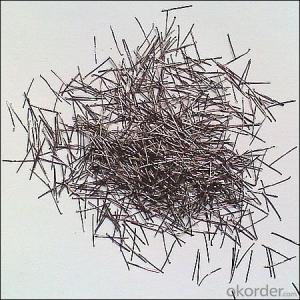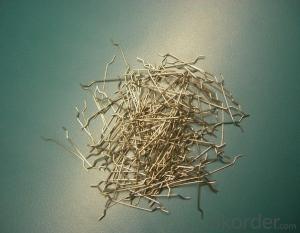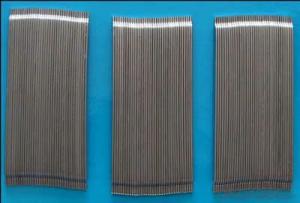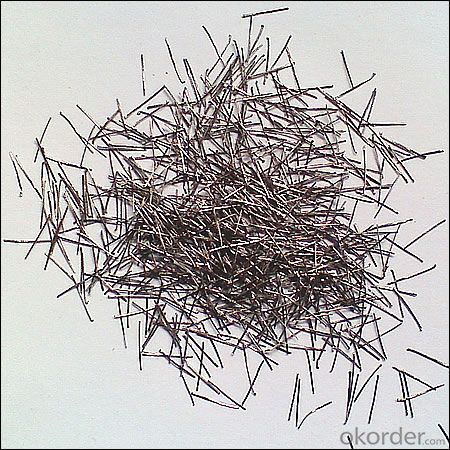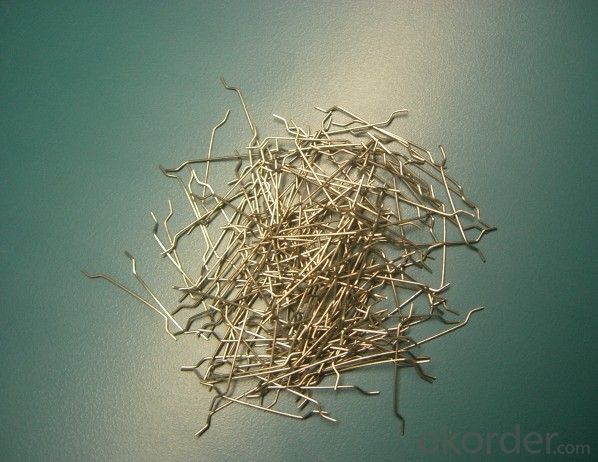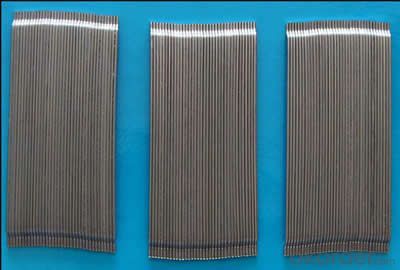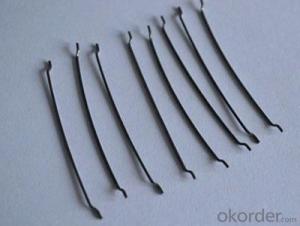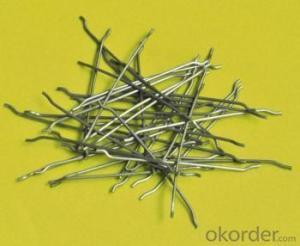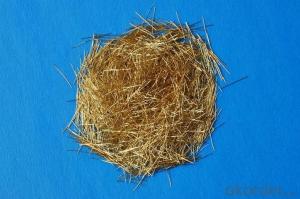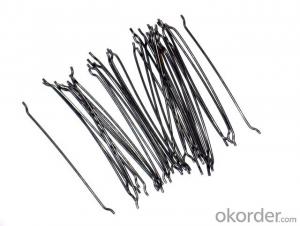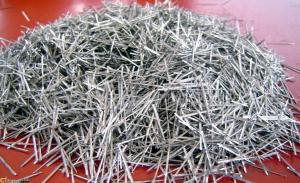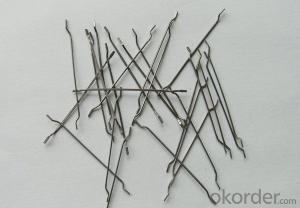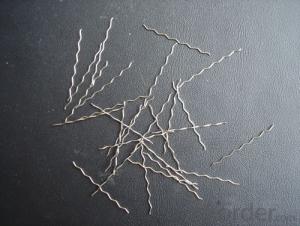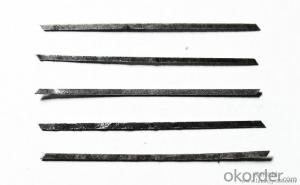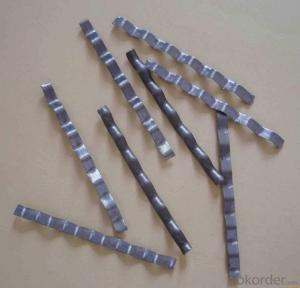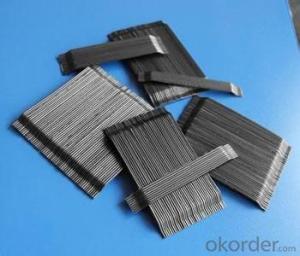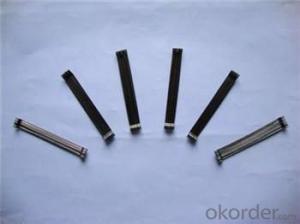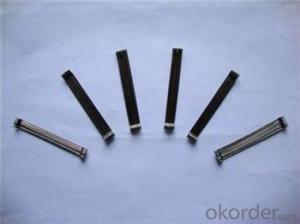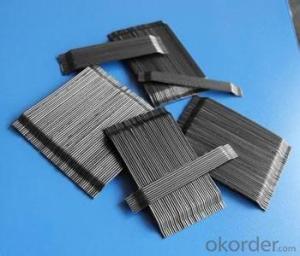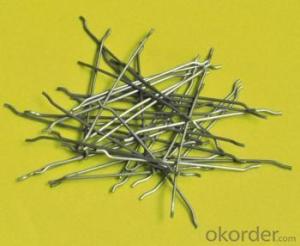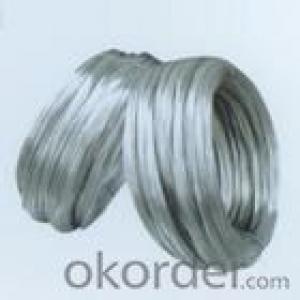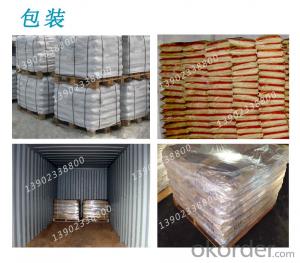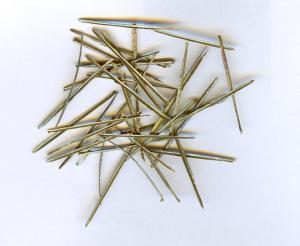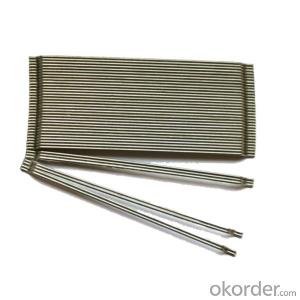Melt Extract Stainless Steel Fiber Airport Runway Cement Buildings
- Loading Port:
- Tianjin
- Payment Terms:
- TT OR LC
- Min Order Qty:
- 1000 kg
- Supply Capability:
- 250000 kg/month
OKorder Service Pledge
OKorder Financial Service
You Might Also Like
Quick Details
Place of Origin: Shandong, China (Mainland)
Model Number: steel fiber
material: steel wire
application: concrete reinocement
type: end hook steel fiber
Product features
steel fiber for conatruction and concrete reinforcement,widely uesd in concrete to improve its stabality end hooked steel fiber ,with its high tensile strength ,good scattering and good combination with cenment material concrete steel fiber is specifically designed to enhance concrete in its hardened state ,the uniform distribution of steel fibers throughout the concrete greatly improve concrete bonding and tensile strengh ,addtionally it provides eceptional load stability and durability ,as reliable and efficient concrete reinforement materisl ,it is widely used in buildings ,bridges,thin roof engineering ,highy way etc.
Specifications
1.hooked steel fiber
2.CE and ISO9001:2008
3.diameter from 0.5mm to 1.2mm
4.competitive price,high quality and service
Hooked Steel Fiber:
1.Diameter:0.5mm-1.0mm
2.Length: 25mm-60mm
3.Material: low carbon steel wire
4.Feature: excellent tensile,high tenacity,against cracking,impact and fatigue
5.Uses: high way,tunnel,building,airport road serface and so on .
Picture
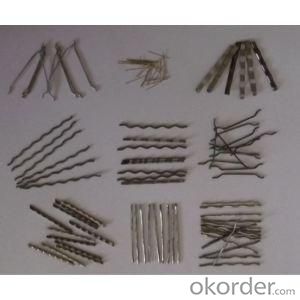
steel fiber concrete reinforced
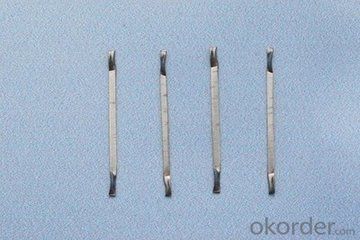
any type steel
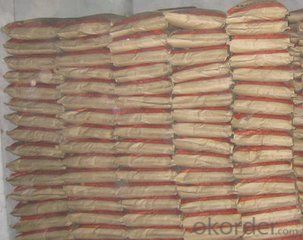
FAQ
we can produce any type steel fiber and of course we can make production according to your requirement
we have specilize in this field for almost 10 years ,with good quality and competitive price
- Q: How does melt extract stainless steel fiber affect the plastic shrinkage of concrete?
- Melt extract stainless steel fiber functions as a reinforcement material incorporated into concrete mixtures to enhance their strength and durability. By reducing plastic shrinkage, this fiber plays a crucial role in minimizing cracks and shrinkage. Plastic shrinkage refers to the decrease in volume of concrete during its early hardening stage, caused mainly by water evaporation from the surface. This shrinkage can result in cracks that compromise the structural integrity of the concrete. However, the inclusion of melt extract stainless steel fiber in the concrete mixture considerably reduces plastic shrinkage. The presence of stainless steel fibers in the concrete ensures even distribution of stress throughout the mixture. This uniform stress distribution prevents the formation of large cracks and decreases overall shrinkage potential. Acting as reinforcement, the fibers provide additional tensile strength to the concrete matrix, making it more resistant to shrinkage-induced cracks. Moreover, melt extract stainless steel fibers enhance the ductility and toughness of the concrete. This increased toughness helps to absorb and distribute any stresses or strains that may occur during the plastic shrinkage process. Consequently, the concrete becomes more resistant to cracking and exhibits improved durability. In conclusion, the addition of melt extract stainless steel fiber to concrete mixtures positively impacts plastic shrinkage. By reinforcing the concrete matrix and effectively distributing stress, these fibers minimize shrinkage-induced cracks and enhance the strength and durability of the concrete.
- Q: What is the recommended mix design for concrete containing melt extract stainless steel fiber?
- When incorporating melt extract stainless steel fiber into concrete, it is advised to use a larger amount of fibers compared to traditional mix designs. This is due to the higher aspect ratio and superior tensile strength of stainless steel fibers, which enhance reinforcement and crack resistance in the concrete. The specific fiber dosage may vary depending on the intended application and desired performance characteristics of the concrete. However, a general recommendation is to use between 1% and 2% of stainless steel fibers by volume. This dosage range has been proven to offer optimal reinforcement and enhance the overall durability of the concrete. In addition to the fiber dosage, it is crucial to take into account other factors such as the water-cement ratio, aggregate gradation, and selection of admixtures. The water-cement ratio should be meticulously controlled to ensure a workable mix with sufficient strength. The aggregate gradation should be optimized to achieve a compact and robust concrete matrix. Furthermore, admixtures can be employed to improve workability, pumpability, and setting time of the concrete. To determine the specific mix design parameters for a project involving melt extract stainless steel fiber, it is advisable to consult with a qualified engineer or concrete supplier. In summary, the recommended mix design for concrete containing melt extract stainless steel fiber involves a higher fiber dosage, careful control of the water-cement ratio, optimization of aggregate gradation, and appropriate use of admixtures. By following these guidelines, a high-performance concrete with enhanced reinforcement and durability properties can be achieved.
- Q: What is the effect of melt extract stainless steel fiber on the fatigue life of asphalt mixtures?
- The use of melt extract stainless steel fiber in asphalt mixtures has a positive effect on the fatigue life. The presence of these fibers improves the overall strength and durability of the asphalt mixture, reducing the occurrence of cracks and fatigue failure. The fibers act as reinforcement, enhancing the asphalt's resistance to repetitive loading and increasing its fatigue life.
- Q: Can melt extract stainless steel fiber be used in bridge decks or infrastructure projects?
- Melt extract stainless steel fiber is indeed applicable for use in bridge decks and infrastructure projects. This particular fiber is renowned for its exceptional tensile strength, resistance to corrosion, and long-lasting nature, which renders it highly suitable for challenging applications like bridge decks. By incorporating these stainless steel fibers into the concrete, its flexural strength, crack resistance, and overall durability can be significantly enhanced. Moreover, the melt extract stainless steel fibers serve to fortify the concrete against harsh environmental conditions, such as freeze-thaw cycles and chemical exposure. As a result, the utilization of melt extract stainless steel fiber in bridge decks and infrastructure projects can effectively prolong the lifespan of these structures while simultaneously reducing maintenance expenses.
- Q: Can melt extract stainless steel fiber be used in industrial flooring or pavements?
- Yes, melt extract stainless steel fiber can be used in industrial flooring or pavements. Melt extract stainless steel fiber is a high-strength, corrosion-resistant material that offers excellent durability and performance in demanding industrial environments. It can enhance the mechanical properties of concrete, such as increasing its tensile strength and crack resistance. In industrial flooring or pavements, where heavy machinery, constant traffic, and exposure to chemicals and harsh conditions are common, the use of melt extract stainless steel fiber can provide significant benefits. It can help in preventing cracking and spalling, improving the overall durability and longevity of the flooring or pavement. Additionally, the use of melt extract stainless steel fiber can reduce the need for traditional reinforcement methods, such as steel bars or mesh, saving time and labor costs during construction. It also provides a more uniform distribution of reinforcement throughout the concrete, reducing the risk of localized failure. Overall, melt extract stainless steel fiber is a suitable choice for industrial flooring or pavements due to its high strength, corrosion resistance, and ability to enhance the mechanical properties of concrete. Its use can result in improved performance, increased durability, and cost savings in the long run.
- Q: How does melt extract stainless steel fiber improve the ductility of shotcrete?
- Melt extract stainless steel fiber improves the ductility of shotcrete by enhancing its ability to withstand deformation and cracking. The addition of stainless steel fibers to the shotcrete mix creates a reinforced matrix that provides increased tensile strength and flexural capacity. When shotcrete is applied, it undergoes a curing process where it hardens and gains strength. However, without any reinforcement, shotcrete is prone to cracking under tensile stresses. By incorporating melt extract stainless steel fibers, the shotcrete gains improved ductility as the fibers distribute the tensile forces throughout the material, preventing the formation and propagation of cracks. The unique properties of stainless steel, such as its high tensile strength and corrosion resistance, make it an ideal material for reinforcing shotcrete. The fibers are uniformly dispersed within the shotcrete mix, providing a three-dimensional reinforcement system that enhances its structural integrity. The addition of stainless steel fibers also improves the overall durability of shotcrete. The fibers act as a barrier to prevent the penetration of water and other harmful substances, reducing the risk of corrosion and deterioration. This ensures a longer service life and minimizes the need for costly maintenance and repairs. In summary, melt extract stainless steel fiber improves the ductility of shotcrete by reinforcing its structure and enhancing its ability to withstand tensile stresses and deformation. By incorporating these fibers, shotcrete gains increased strength, durability, and resistance to cracking, ultimately improving its performance and extending its lifespan.
- Q: Can melt extract stainless steel fiber be used in precast tunnel invert segments?
- Precast tunnel invert segments can indeed utilize melt extract stainless steel fiber. This type of stainless steel fiber is commonly employed in precast concrete applications to bolster the concrete's mechanical properties and endurance. By offering exceptional crack resistance, impact resistance, and ductility, it significantly enhances the concrete's overall performance. Due to its high tensile strength and corrosion resistance, melt extract stainless steel fiber is particularly well-suited for deployment in challenging environments like tunnels. Its utilization aids in the enhancement of flexural strength and load-bearing capacity in precast tunnel invert segments, thereby guaranteeing their long-term structural integrity. Moreover, the inclusion of stainless steel fiber can also diminish the necessity for traditional reinforcement, streamlining the production process and reducing expenses.
- Q: The heavy steel fiber feifanshi supeiflat floor for what?
- Feifanshi steel fiber heavy-duty supeiflat floor walk forklift high level rack of logistics distribution center
- Q: What are the different quality standards and certifications for melt extract stainless steel fiber?
- Melt extract stainless steel fiber must adhere to various quality standards and certifications to ensure its performance and quality. Here are some of the most common ones: 1. ISO 9001: This international standard guarantees that the manufacturer has a consistently effective quality management system that meets customer requirements and regulatory obligations. 2. ASTM International: Globally recognized for setting standards, ASTM International has developed specific standards for stainless steel fibers. For instance, ASTM A820 focuses on steel fibers for fiber-reinforced concrete, while ASTM A1094 deals with steel fibers for concrete reinforcement. 3. EN Eurocodes: The Eurocodes are a collection of European standards for structural design. EN 14889-1 is the specific European standard for steel fibers used in concrete reinforcement, outlining requirements for mechanical properties, dimensions, and durability. 4. AISI: The American Iron and Steel Institute (AISI), representing North American steel producers, has established AISI 304 or AISI 316 as specifications for stainless steel fibers. These specifications cover chemical composition, mechanical properties, and other fiber characteristics. 5. CE Marking: CE marking is compulsory for certain products sold in the European Economic Area (EEA). It signifies compliance with essential health, safety, and environmental requirements specified in European Union directives. 6. ICC-ES: The International Code Council Evaluation Service (ICC-ES) offers evaluation reports and certifications for building products. Their evaluation criteria ensure that steel fibers employed in concrete reinforcement meet specific safety and performance requirements. It is essential to consider that the applicable quality standards and certifications for melt extract stainless steel fiber may vary depending on its intended application. Consulting the manufacturer or supplier is recommended to determine the relevant standards and certifications for a particular product.
- Q: Can melt extract stainless steel fiber be used in bridge deck overlays for asphalt mixtures?
- Yes, melt extract stainless steel fiber can be used in bridge deck overlays for asphalt mixtures. The addition of stainless steel fibers enhances the overall performance and durability of the asphalt mixtures. The fibers help to improve the tensile strength, crack resistance, and fatigue resistance of the asphalt overlay. This is particularly beneficial for bridge deck overlays, as they are subjected to heavy traffic loads, temperature fluctuations, and exposure to various environmental conditions. The stainless steel fibers also provide reinforcement to prevent the formation and propagation of cracks, which helps to prolong the service life of the bridge deck. Additionally, the corrosion-resistant properties of stainless steel make it suitable for use in bridge deck overlays, where exposure to moisture and deicing salts is common. Overall, incorporating melt extract stainless steel fibers in bridge deck overlays for asphalt mixtures is a viable option to improve the performance and longevity of the overlay system.
Send your message to us
Melt Extract Stainless Steel Fiber Airport Runway Cement Buildings
- Loading Port:
- Tianjin
- Payment Terms:
- TT OR LC
- Min Order Qty:
- 1000 kg
- Supply Capability:
- 250000 kg/month
OKorder Service Pledge
OKorder Financial Service
Similar products
Hot products
Hot Searches
Related keywords
